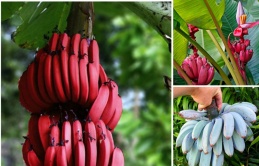The Enigma of the Four-Legged Tree: Unraveling a Natural Marvel
In the vast and diverse realm of nature, where creatures both big and small roam, one might assume that a tree’s defining characteristic is its trunk, branches, and foliage.
22:58 18/05/2023
However, prepare to be amazed, as we delve into the extraordinary world of a peculiar botanical anomaly: the four-legged tree. Yes, you read that correctly – a tree with four legs. In this article, we will explore the intriguing characteristics and possible explanations behind this captivating phenomenon.

Picture a majestic tree standing tall amidst a lush forest, but instead of its roots being deeply anchored in the ground, it stands upon four sturdy legs. These extraordinary specimens, with their trunk extending above the forest floor, challenge our conventional understanding of trees and defy the laws of nature. Their intriguing presence has captivated botanists, researchers, and nature enthusiasts alike.

The four-legged tree, scientifically known as Arbor quadrus, exhibits several unique characteristics that set it apart from its traditional counterparts. Its legs, akin to robust pillars, provide stability and support, allowing the tree to grow taller and more prominent. The legs, formed by specialized root structures, spread out evenly around the base of the trunk, ensuring balance and preventing toppling in strong winds or adverse conditions.

This remarkable adaptation offers the four-legged tree distinct advantages. By elevating its trunk, the tree gains a competitive edge in light acquisition, surpassing neighboring vegetation and maximizing exposure to sunlight. The increased height also aids in seed dispersal, as wind currents can carry seeds farther, enhancing the tree’s ability to colonize new areas.

The evolutionary origins of the four-legged tree remain a subject of scientific intrigue and debate. Several hypotheses have been proposed to explain this unusual adaptation. One theory suggests that the legs developed as a response to flooded environments, allowing the tree to raise its trunk above water levels and avoid waterlogging. Another hypothesis suggests that the legs evolved as a defense mechanism against herbivores, making it difficult for them to access the leaves and limiting damage to the tree.

While the four-legged tree’s existence is still relatively obscure, efforts are underway to study and conserve these extraordinary specimens. Researchers are examining the genetic makeup and ecological significance of these trees, aiming to unravel the secrets behind their unique adaptation. Conservation measures are also being implemented to protect their habitats and ensure their long-term survival.

In the ever-surprising world of nature, the four-legged tree stands out as a remarkable anomaly, challenging our preconceptions about the form and function of trees. With their intriguing characteristics and possible explanations, these exceptional botanical wonders inspire awe and curiosity among those fortunate enough to encounter them. As we continue to explore and understand this captivating phenomenon, let us appreciate the diversity and ingenuity of the natural world and strive to protect these extraordinary trees for future generations to marvel at.

Experience Nature's Sweetest Delight: Indulge in the Enchanting Beauty of Ripe Strawberries Thriving Amongst Lively Foliage!
Step into a world of sensory delight as you embark on a journey through the enchanting realm of strawberries. Amidst a backdrop of vibrant green foliage, nature unveils a truly breathtaking spectacle—the magnificent sight of luscious strawberries in full bloom.






















